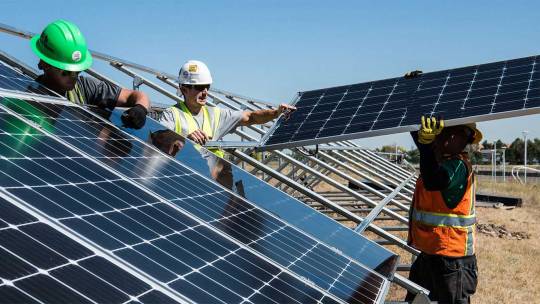#solar independent power producers
Text
Best solar panel company

Installing a 3kW solar panel system in any location, can offer several benefits:
Lower Electricity Bills: By harnessing the sun's energy to create electricity, a solar panel system helps you become less reliant on the grid. Lower electricity bills may arise from this, particularly in the summer months when the system generates more energy.
Environmentally Friendly: Compared to conventional fossil fuels, solar energy is a clean, renewable energy source that has less of an influence on the environment. By lowering greenhouse gas emissions, solar panel adoption promotes environmental sustainability.
Financial Incentives: To encourage the installation of solar panels, several countries provide tax breaks, subsidies, or other financial incentives. Solar energy becomes more economically appealing when these incentives are applied, as they can considerably reduce the initial installation costs.
Energy Independence: You can reduce your dependency on outside energy sources by producing your own electricity. In the event of grid failures or shifting energy rates, this independence can offer stability and resilience.
Minimal Maintenance Costs: In general, solar panels don't require much maintenance. Usually, periodic inspections and routine cleaning are enough to guarantee peak performance. When compared to some alternative methods of producing power, this may lead to lower long-term running expenses.
Enhanced Property Value: Houses equipped with solar panels are frequently thought to be more energy- and environmentally-efficient. This makes it a wise investment for homeowners as it may raise the value of their property.
System Support and Net Metering: In certain places, surplus solar energy can be reinjected into the system.
Long Lifespan: The average lifespan of best Solar Panel is more than 25 years. This implies that they can give a dependable and long-lasting energy solution by continuing to save energy after installation for a considerable amount of time.
Decreased Carbon Footprint: By utilizing solar power, you may help fight climate change by reducing carbon emissions. This beneficial effect on the environment may serve as inspiration for people who want to switch to more sustainable behaviors.
Energy Security: In places that are vulnerable to power outages or have unstable grid infrastructure, solar energy can offer some degree of energy security. Being able to produce electricity locally lowers susceptibility to outside disturbances.
visit site
#Solar EPC Solution Provider in Gujarat#Leading Solar Energy Company in Gujarat#Best Solar Company#Independent Power Producer Company#Best Solar Panel Installation Company#Solar Power Plant#Solar System Providers#solar captive power plant#captive power producer#Best Solar EPC Company#solar company in surat#solar plant in surat#leading solar energy company in gujarat#solar panel company in surat#best solar panel company#Solar power plant in Gujarat#solar independent power producers#solar manufacturing company in surat#solar company in gujarat#solar energy companies in gujarat#solar companies in surat#captive power plant in gujarat#Top Solar Companies in Gujarat#solar epc company#solar independent power producers in gujarat#leading solar energy company in surat#independent power producer in gujarat#industrial solar power plants in surat#best solar panel compay in surat#best solar epc company in surat
0 notes
Text
5 Important Factors to Consider When Selecting An Independent Power Producer

When selecting an Independent Power Producer (IPP) for your energy needs, several crucial factors should guide your decision to ensure sustainability, cost-effectiveness, and reliability. Below are five essential considerations:
1. Regulatory Environment and Support Mechanisms
When embarking on a project with an Independent Power Producer, understanding the regulatory environment is paramount. Regions vary significantly in their regulatory frameworks, which can either enable or hinder project development. Support mechanisms such as feed-in tariffs (FITs) or power purchase agreements (PPAs) provide a long-term price guarantee, making them critical in assessing the financial viability of projects. For instance, FITs offer a set price for energy supplied to the grid, encouraging investment in renewable energy by guaranteeing returns on investment.
Key Considerations:
Compliance: Ensure the IPP adheres to all local and international regulations, which govern everything from project initiation to energy distribution and environmental compliance.
Stability: Political and economic stability can affect the implementation of regulatory frameworks, impacting project timelines and profitability.
Adaptability: Regulatory environments are dynamic. An ideal IPP should demonstrate flexibility and an ability to adapt to regulatory changes.
2. Technological Expertise
The choice of technology is critical when selecting an Independent Power Producer Company. Each technology, from solar photovoltaics to wind turbines or hydroelectric power, comes with its own set of challenges and requirements. An IPP with a solid track record in a specific technology offers reliability and a higher assurance of project success.
Tips for Assessing Technological Expertise:
Experience: Review past projects to evaluate the IPP’s expertise and success rate.
Innovation: Consider whether the IPP is a leader in adopting new technologies or methodologies that could enhance the efficiency and sustainability of power production.
Resource Management: Efficient management of both human and natural resources is crucial, especially in renewable energy projects where variability can impact power generation.
Things to Look out For :
Hybrid Systems: Combining solar and wind power to maximize efficiency and output.
Energy Storage: Advances in battery technologies that enhance energy storage capacity are crucial for balancing supply and demand.
Dos and Don'ts:
Do: Choose an IPP known for technological innovation and a proven track record in deploying complex energy projects.
Don't: Overlook the importance of ongoing technical support and project management expertise.
3. Financial Stability and Investment Capacity
The financial health of an Independent Power Producer in Gujarat or any region is indicative of its capacity to sustain operations and fulfill long-term project commitments. Financial stability ensures that the IPP can withstand economic downturns and continue to invest in technological advancements.
Things to Consider:
Capital Investment: Adequate funding not only for the initial setup but also for future expansions and upgrades.
Debt-to-Equity Ratio: A balanced ratio suggests prudent financial management and investment safety.
Revenue Streams: Diversified revenue sources provide stability and reduce dependency on a single market.
Investor Confidence: Strong relationships with financial institutions and investors can indicate an IPP’s credibility and stability.
By meticulously analyzing these factors, stakeholders can make informed decisions when selecting an IPP, ensuring that their investment is secure and capable of meeting future energy demands effectively.
4. Environmental and Social Impact
Environmental responsibility is increasingly at the forefront of corporate governance within the energy sector. An Independent Power Producer must not only comply with environmental regulations but also exceed them to ensure minimal negative impact. This commitment is often reflected in the adoption of sustainable practices that protect local ecosystems and enhance biodiversity.
Environmental Considerations:
Emissions and Waste: Evaluate the measures the IPP takes to minimize emissions and waste during the power generation process.
Biodiversity: Consider the impact of projects on local wildlife and habitats, and the IPP's efforts in promoting biodiversity.
Renewable Technologies: Preference should be given to IPPs that use or develop renewable energy technologies, thereby reducing reliance on fossil fuels and promoting sustainability.
Social Considerations:
Community Engagement: Successful IPPs often engage with local communities to ensure their projects are well-received and beneficial. This includes employment opportunities, infrastructure improvements, and educational initiatives.
Health and Safety: The health and safety practices of the IPP are paramount, particularly in how they protect both their workforce and the local population from potential harm associated with the energy generation.
5. Local Integration and Market Penetration
A deeply integrated Independent Power Producer in Gujarat or any locality enhances its operational success and market responsiveness. Local integration involves understanding regional energy demands, adapting to local regulatory changes, and contributing positively to the local economy.
Considerations for Effective Market Penetration:
Cultural Alignment: Understanding and respecting local customs and business practices can significantly impact project acceptance and success.
Local Partnerships: Collaborations with local businesses can streamline operations and facilitate smoother market entry.
Infrastructure Compatibility: Ensuring that the IPP’s facilities can connect seamlessly with existing distribution networks is critical for operational efficiency.
Regulatory Compliance: Ensure the IPP is up-to-date with local laws and regulations, which is crucial for smooth operations and expansion.
Why Choose KP Group for Your Renewable Energy Solutions?
At KP Group, we pride ourselves on over 29 years of pioneering eco-friendly and innovative renewable energy solutions. Our extensive experience in solar and wind energy projects in Gujarat, coupled with our leadership in emerging green technologies like Green Hydrogen, positions us uniquely in the energy sector.
Choosing KP Group means partnering with a leader dedicated to advancing renewable energy and ensuring energy independence for businesses across India. We are here not just to meet current energy needs but to innovate and prepare for future demands. Join us in building a more sustainable and energy-secure future.
Source URL:
0 notes
Text
An independent power producer, Sunsource Energy Pvt. Ltd. proudly spearheaded the implementation of an on-site solar power project at a prominent automotive company in Maharashtra. This initiative not only substantially curbed the organization's energy costs but also propelled its transition towards cleaner, more sustainable energy sources. With an estimated CO2 offset of an impressive 24 million kilograms, this endeavor is a significant stride towards environmental conservation. Commissioned in 2021, the project is equivalent to planting an astounding 45,000 trees, underscoring the impactful shift towards greener energy solutions.
0 notes
Text
NETHER

Inhabitants: Majority Blaze hybrids
Major biomes: desert
History:
Sharing the same solar system as Spawn, and being within habitable range, the Nether has a history that tracks back as far as Spawn, including the nature of how the planet influenced the evolution of the Blaze Hybrid.
The planet has an extremely hot and hostile environment, but even despite that, it is home to more than just Blaze Hybrids, especially on the colder sides of the planet, the planet is rich in resources and energy.
The Nether, unlike other settlements, doesn’t possess one two authority that rules over it. It remains pretty untouched by forces such as The Vindicators and The Enders. This is suspected to be due to the very every man for himself nature of this planet which possesses all kinds of rare resources, forcing the Factions to compete for them. The Nether is a very hostile planet making it hard to build any industry. As outsiders who aren’t familiar with the land, they cannot tap into the monopoly there. It makes sense why The Vindicators or The Enders have not touched it at all.
The cooler side of the planet is filled with thriving and independent settlements that all trade in materials such as Blaze Powder and Netherite, under all kinds of rule or communities. It’s produced some very unique and diverse forms of cultures, and shares materials off planet often.
Reign/ruler: outlaw / non
Climate: hot
Major trade: Blaze Power, Netherite
Major city(s):
BADLANDS (click for more info)

<<Return to universe map
21 notes
·
View notes
Text
Unfinished Timeline for an Untitled Setting
Critique and advice is more than welcome, though please be nice about it. Goes up to about 2081 rn, though I plan to get at least another 50 years further in before I get to the time I want the bulk of the setting to be set in.
Timeline:
2022: First controlled break-even fusion reaction, followed by first controlled net-gain fusion reaction.
2025-2026: Increasing unrest in USA leads to mass riots outside the white-house. Sweeping reforms after growing revolts threaten to become a major armed rebellion. NASA miraculously left untouched, general increase in standard of living. Economic crisis narrowly averted.
2027: First nuclear thermal rocket (NTR) tested in orbit by NASA and DARPA. GPT-style language modeling declared “dead end” for self-aware AI.
2030: First Lunar base established under NASA Artemis program. Suez Canal temporarily blocked by a poorly driven cargo ship again. Evergreen Shipping goes bankrupt.
2034: Lunar Gateway established under joint NASA, ESA, JAXA, DLR, ASI, and CNSA. Lunar helium-3 mining declared officially nonviable. Radial detonation engines become standard for lower ascent stages, SpaceX Starship, NASA SLS, and Roscosmos Soyuz phased out. Drop in launch prices.
2034-2036: Additional modules added to the Lunar Gateway from SpaceX, KARI, ISRO, and Roscosmos. Lunar Gateway Collaborative Group (LGCG) established consisting of all current contributors to the station.
2036: First commercial fusion energy plant reaches full operation in France under ITER. Mass production of Tritium begins. First fully private space station under SpaceX. Asteroid mining corporations begin formation. Establishment of Nigerian Organization for the Development of Space (NODS). Ecuador experiences communist revolution.
2036-2037: First manned martian mission under LGCG, first human footsteps on another planetary body.
2037: Elon Musk assassinated. New SpaceX leadership declares plans for space elevator. North Korea collapses, Korean peninsula unified under South Korean leadership, becoming simply Korea. Indian nuclear stockpile secretly surpasses 50000 Gt. First baby born on the moon.
2040: Artemis base becomes semi-self sufficient, producing it’s own food and air from hydroponics, and water from mined lunar ice. Lunar LH2 and hydrolox production begins. Lunar population passes 100.
2040-2042: First commercial fusion power plants established in the US, UK, Australia, Korea, and Japan.
2042: A joint US Government and SpaceX black operation destabilizes Ecuador, leading to a corporate takeover of the territory.
2044: Korea, Japan, the Philippines, Vietnam, Malaysia, Indonesia, Papua New Guinea, Australia, and New Zealand form West Pacific Trade Organization (WPTO). Construction of the base of SpaceX’s planned space elevator begins off the coast of Ecuador.
2047: LCC completed at CERN. Mission for permanent martian base declared. Major economic crisis in China, intervention from several megacorps results in a decrease in Chinese government power and increase in corporate control in the region. SpaceX space elevator counterweight construction begins in geostationary orbit.
2048: Major revolution in quantum mechanics brought on by new data from the LCC. Lunar population passes 250.
2050: China splits into 4 corporate states, Amazon Corporate Territory (ACT) with its capitol in Chongqing, Samsung Independent State (SIS) with its capitol in Shanghai, Territory for Electronic Developments (TED) made up of Apple and Microsoft with its capitol in Yinchuan, and the Chinese Corporate Union (CCU) made up of several formerly state-owned corporations with their capitol in Wuhan and possession of the Three Gorges Dam. Beijing becomes an independent city-state controlled by the former Chinese government, retaining control over the CNSA. Massive revolution in battery energy density. Permanent martian base established by LGCG.
2051: Breakthrough in photon manipulation, beamed energy and solar collection becomes increasingly viable. Many asteroid mining corps branch into solar power, notably Binghamton Vacuum Mining Solutions (BVMS). Lunar population passes 500.
2052: Martian population surpasses 100.
2053: Martian base reaches semi-self sustainability.
2055: All 4 Chinese corporate states and the Beijing city state form the Chinese Federation for Space Exploration (CFSE), supplanting the old CNSA. Lunar Gateway module renamed and LGCG roster amended accordingly. SpaceX space elevator cable completed, first test cart sent to GEO. WPTO begins construction of a space elevator in the Banda Sea.
2056: SpaceX space elevator declared complete, commercial operation begins.
2057: BVMS surpasses $1T in net worth, becomes primary supplier of energy for the Artemis Lunar Base. Lunar Population surpasses 1k, massive migratory population surge begins following influx of energy from BVMS. Martian population surpasses 250. First fusion reactor in Ecuador.
2058: WPTO space elevator counterweight begins construction in GEO.
2060: First fusion reactors in Nigeria and India. First large-scale solar collector on Earth constructed in New York operated by BVMS. Large population surge in Binghamton NY. Lunar population surpasses 5k. Martian space station established. Regulations for GEO development established.
2061: First lunar-built spacecraft flown. Secondary lunar settlement founded by CFSE. Massive influx of funds for the WPTO space elevator from the CFSE, GEO counterweight construction begun. Lunar Gateway population surpasses 100. First fusion reactor in the Democratic Republic of the Congo (DRC), Congo space agency (DRCSA) founded.
2064: WPTO space elevator cable completed, declared complete and opened to commercial operation.
2065: BVME establishes unmanned Mercurian base. CFSE settlement population surpasses 100. Martian population surpasses 500. Lunar Gateway population surpasses 200.
2066: Mass expansion of Artemis Base life support systems using BVMS produced automated construction equipment. Aerostat scientific outpost established by LGCG.
2067: Microbial life discovered on Venus. Venus outpost (and LGCG) acquires substantial funding boost. Artemis base population surpasses 2.5k and begins to plateau.
2069: Unmanned mission to Europa announced by LGCG, plans to use BVMS automated platforms to drill into subsurface ocean established. Martian base purchases automated construction equipment from BVMS, massive population boon ensues. CFSE settlement population surpasses 750. Lunar gateway population surpasses 500. Martian base population surpasses 500. BVME becomes the largest corporate entity in the system.
2070: BVMS performs feasibility study on gas giant aerostat mining platforms.
2071: Study of Venusian lifeforms disproves Earth-Venus panspermia.
2073: BVMS tests laser-sail propulsion on small unmanned craft.
2075: LGCG Europa mission discovers multicellular aquatic life in Europa’s subsurface ocean. Plans for a dedicated research base drafted.
2076: Multi-corporate base established on Ceres to facilitate further asteroid belt mining. BVMS intentionally excluded from this project.
(System effectively split into quarters: Past Venus under BVMS, Between Venus and Mars under LGCG, belt under Multi-corporate mining control, outer system unclaimed.)
2077: GEO-Lunar cycler niche mostly filled by Intraplanetary Transport Services corp (ITS).
2080: Permanent scientific base established at the Europa Breach Point (EBP) with mostly automated systems and a small (5 human) management and maintenance crew.
2081: Panspermia further disproved by study of Europan life. Massive object detected in Jupiter’s lower atmosphere. BVMS begins mission to establish a mining aerostat on Saturn, utilizing laser sail propulsion to transport equipment.
(Saturn Aerostat site intended for use in the further colonization of the outer solar system and the Uranus planetary system itself. Atomic Rockets page)
9 notes
·
View notes
Text

New SpaceTime out Friday...
SpaceTime 20230929 Series 26 Episode 117
NASA's Parker Solar Probe hit by powerful Coronal mass ejection
NASA's Parker Solar Probe has just flown through one of the most powerful coronal mass ejections ever recorded.




The most difficult climb of Curiosity’s mission so far
It’s taken three attempts but NASA’s Mars Curiosity rover has finally arrived at Gediz Vallis Ridge a mound of mud and boulders piled up by a powerful ancient flood.







Have alien mummies turned up in Mexico
Mexican lawmakers shown what are claimed to be the a pair of tiny thousand year-old mummified extraterrestrial alien bodies.

The Science Report
A vegan diet not only helps you lose weight, but also save you money.
Increased death rates for people who come to emergency departments with alcohol-related diseases.
A new study suggests your probably happiest when you’re a little kid.
SpaceTime covers the latest news in astronomy & space sciences.
The show is available every Monday, Wednesday and Friday through Apple Podcasts (itunes), Stitcher, Google Podcast, Pocketcasts, SoundCloud, Bitez.com, YouTube, your favourite podcast download provider, and from www.spacetimewithstuartgary.com
SpaceTime is also broadcast through the National Science Foundation on Science Zone Radio and on both i-heart Radio and Tune-In Radio.
SpaceTime daily news blog: http://spacetimewithstuartgary.tumblr.com/
SpaceTime facebook: www.facebook.com/spacetimewithstuartgary
SpaceTime Instagram @spacetimewithstuartgary
SpaceTime twitter feed @stuartgary
SpaceTime YouTube: @SpaceTimewithStuartGary
SpaceTime -- A brief history
SpaceTime is Australia’s most popular and respected astronomy and space science news program – averaging over two million downloads every year. We’re also number five in the United States. The show reports on the latest stories and discoveries making news in astronomy, space flight, and science. SpaceTime features weekly interviews with leading Australian scientists about their research. The show began life in 1995 as ‘StarStuff’ on the Australian Broadcasting Corporation’s (ABC) NewsRadio network. Award winning investigative reporter Stuart Gary created the program during more than fifteen years as NewsRadio’s evening anchor and Science Editor. Gary’s always loved science. He studied astronomy at university and was invited to undertake a PHD in astrophysics, but instead focused on his career in journalism and radio broadcasting. He worked as an announcer and music DJ in commercial radio, before becoming a journalist and eventually joining ABC News and Current Affairs. Later, Gary became part of the team that set up ABC NewsRadio and was one of its first presenters. When asked to put his science background to use, Gary developed StarStuff which he wrote, produced and hosted, consistently achieving 9 per cent of the national Australian radio audience based on the ABC’s Nielsen ratings survey figures for the five major Australian metro markets: Sydney, Melbourne, Brisbane, Adelaide, and Perth. The StarStuff podcast was published on line by ABC Science -- achieving over 1.3 million downloads annually. However, after some 20 years, the show finally wrapped up in December 2015 following ABC funding cuts, and a redirection of available finances to increase sports and horse racing coverage. Rather than continue with the ABC, Gary resigned so that he could keep the show going independently. StarStuff was rebranded as “SpaceTime”, with the first episode being broadcast in February 2016. Over the years, SpaceTime has grown, more than doubling its former ABC audience numbers and expanding to include new segments such as the Science Report -- which provides a wrap of general science news, weekly skeptical science features, special reports looking at the latest computer and technology news, and Skywatch – which provides a monthly guide to the night skies. The show is published three times weekly (every Monday, Wednesday and Friday) and available from the United States National Science Foundation on Science Zone Radio, and through both i-heart Radio and Tune-In Radio.
#science#space#astronomy#physics#news#nasa#esa#asa#rocket#spacetimewithstuartgary#starstuff#spacetime#astrophysics
21 notes
·
View notes
Text

LETTERS FROM AN AMERICAN
December 27, 2023
HEATHER COX RICHARDSON
DEC 28, 2023
Fifty years ago tomorrow, on December 28, 1973, President Richard Nixon signed the Endangered Species Act into law. Declaring that Congress had determined that “various species of fish, wildlife, and plants in the United States have been rendered extinct as a consequence of economic growth and development untempered by adequate concern and conservation,” the act provided for the protection of endangered species.
Just over a decade before, in 1962, ecologist Rachel Carson had published Silent Spring, documenting how pesticides designed to eliminate insects were devastating entire ecosystems of linked organisms. The realization that human destruction of the natural world could make the planet uninhabitable spurred Congress in 1970 to create the Environmental Protection Agency. And in 1973, when Nixon called for stronger laws to protect species in danger of extinction, 194 Democrats and 160 Republicans in the House—99% of those voting—voted yes. Only four Republicans in the House voted no.
Such strong congressional support for protecting the environment signaled that a new era was at hand. While President Gerald Ford, who succeeded Nixon, tended to dial back environmental protections when he could in order to promote the development of oil and gas resources, President Jimmy Carter pressed the protection of the environment when he took office in 1977.
In 1978, Carter placed 56 million acres of land in Alaska under federal protection as national monuments, doubling the size of the national park system. “These areas contain resources of unequaled scientific, historic and cultural value, and include some of the most spectacular scenery and wildlife in the world,” he said. In 1979 he had 32 solar panels installed at the White House to help heat the water for the building and demonstrate that it was possible to curb U.S. dependence on fossil fuels. Just before he left office, Carter signed into law the Alaska National Interest Lands Conservation Act, protecting more than 100 million acres in Alaska, including additional protections for the Arctic National Wildlife Refuge.
Oil companies, mining companies, timber companies, the cattle industry, and local officials eager for development strongly opposed Carter’s moves to protect the environment. In Alaska, local activists deliberately broke the regulations in the newly protected places, portraying Carter as King George III—against whom the American colonists revolted in 1776—and insisting that the protection of lands violated the promise of life, liberty, and the pursuit of happiness promised in the Declaration of Independence.
For the most part, though, opposition to federal protection of the environment showed up as a drive to reform government regulations that, opponents argued, gave far too much power to unelected bureaucrats. In environmental regulations, the federal government’s protection of the public good ran smack into economic development.
In their 1980 presidential platform, Republicans claimed to be committed to “the conservation and wise management of America’s renewable natural resources” and said the government must protect public health. But they were not convinced that current laws and regulations provided benefits that justified their costs. “Too often,” they said, “current regulations are…rigid and narrow,” and they “strongly affirm[ed] that environmental protection must not become a cover for a ‘no-growth’ policy and a shrinking economy.”
In his acceptance speech for the Republican presidential nomination, Ronald Reagan explained that he wanted to see the U.S. produce more energy to fuel “growth and productivity. Large amounts of oil and natural gas lay beneath our land and off our shores, untouched because the present Administration seems to believe the American people would rather see more regulation, taxes and controls than more energy.”
In his farewell address after voters elected Reagan, Carter urged Americans to “protect the quality of this world within which we live…. There are real and growing dangers to our simple and our most precious possessions: the air we breathe, the water we drink, and the land which sustains us,” he warned. “The rapid depletion of irreplaceable minerals, the erosion of topsoil, the destruction of beauty, the blight of pollution, the demands of increasing billions of people, all combine to create problems which are easy to observe and predict, but difficult to resolve. If we do not act, the world of the year 2000 will be much less able to sustain life than it is now.”
“But,” Carter added, “[a]cknowledging the physical realities of our planet does not mean a dismal future of endless sacrifice. In fact, acknowledging these realities is the first step in dealing with them. We can meet the resource problems of the world—water, food, minerals, farmlands, forests, overpopulation, pollution if we tackle them with courage and foresight.”
Reagan began by appointing pro-industry officials James G. Watt and Anne M. Gorsuch (mother of Supreme Court justice Neil Gorsuch) as secretary of the interior and administrator of the Environmental Protection Agency, respectively; they set out to gut government regulation of the environment by slashing budgets and firing staff. But both resigned under scandal in 1983, and their replacements satisfied neither those who wanted to return to the practices of the Carter years nor those who wanted to get rid of those practices altogether.
Still, with their focus on developing oil and gas, when workers repairing the White House roof removed the solar panels in 1986, Reagan administration officials declined to reinstall them.
Forty years later, we are reaping the fruits of that shift away from the atmosphere that gave us the Endangered Species Act and toward a focus on developing fossil fuels. On November 30 the World Meteorological Organization (WMO), an agency of the United Nations, reported that global temperatures in 2023 were at record highs both on land and in the seas, Antarctic sea ice extent is at a record low, and devastating fires, floods, outbreaks of disease, and searing heat waves have pounded human communities this year.
The WMO released this provisional report the same day that the U.N. Climate Change negotiations, known as COP28, began in the United Arab Emirates. United Nations Secretary-General António Guterres urged leaders to commit to act to address climate change, while there was still time to avoid “the worst of climate chaos.” After a year in which countries staggered under extreme weather events, climate change is on people’s minds: nearly 80,000 people, including world leaders and celebrities, registered to attend COP28.
After the convention ended on December 13, Umair Irfan of Vox summarized the agreement hashed out there. For the first time in 27 such conventions, countries explicitly called for the phasing out of fossil fuel…but they didn’t say when or by how much. After taking stock of what countries are doing to address climate change, the meeting concluded that efforts to reduce emissions, invest in technology, adapt to warming, and help suffering countries are all falling short.
In addition to acknowledging the need to move away from fossil fuels, COP28 agreed to cut methane, boost renewable energy considerably, and help countries that are dealing with the fallout from climate change: island nations, for example. But emissions of greenhouse gases continue to rise, and the hope of limiting warmer temperatures to 1.5 degrees Celsius now seems a long shot. Still, renewable energy capacity grew nearly 10% in 2022, led by solar and wind power.
Today President Joe Biden used the anniversary of the Endangered Species Act to reclaim the spirit of the era in which it was written, urging Americans to protect ecosystems and biodiversity, “honor all the progress we have made toward protecting endangered species,” and to “come together to conserve our planet.” He noted that thanks to the Inflation Reduction Act, the Biden-Harris administration has been able to invest billions of dollars in forest management, ecosystem restoration, and protection of watersheds, as well as making historic investments in addressing climate change, and that, as president, he has protected more lands and waters than any president since John F. Kennedy.
And yet the forces that undermined that spirit are still at work. In the 2022 West Virginia v. Environmental Protection Agency decision, the Supreme Court claimed that Congress could not delegate “major questions” to executive agencies, thus limiting the EPA’s ability to regulate the emissions that create climate change; and House Republicans this summer held a hearing on “the destructive cost of the Endangered Species Act,” claiming that it “has been misused and misapplied for the past 50 years” with “disastrous effects on local economies and businesses throughout the United States.” Chair of the House Committee on Natural Resources Bruce Westerman (R-AR) accused the Biden administration of stifling “everything from forest management to future energy production through burdensome ESA regulations.”
While in 1980 voters could react to such a contrast between the parties’ environmental visions ideologically, in 2023, reality itself is weighing in. Brady Dennis of the Washington Post noted today that in this era of rising waters and epic storms, North Carolina has become the fourth state, along with South Carolina, New York, and New Jersey, to require home sellers to disclose their home’s flooding history and flood risk to prospective buyers.
LETTERS FROM AN AMERICAN
HEATHER COX RICHARDSON
#environmentalist#environmental law#climate change#climate emergency#Letters From An American#Heather Cox Richardson#Endangered Species Act#EPA#Environmental Protection Agency#history
12 notes
·
View notes
Text
296, leaving the coastal lands largely unpopulated for the next two centuries. The creation of water boards actually pre-dates that of the nation itself, the first appearing in 1196. It ran Syria under emergency law from 1963 to 2011, effectively suspending constitutional protections for citizens. As of 2007, the unemployment rate of Wallonia is over double that of Flanders. The Spanish faced much resistance from the Pipil and were not able to reach eastern El Salvador, the area of the Lencas. Database entry includes a brief justification of why this species is of endangered. The country was the seventh largest producer of soybean oil in the world in 2018. In 1982, came the K Series, shaft drive but water-cooled and with either three or four cylinders mounted in a straight line from front to back. This fills the holes in the black grid with their corresponding colored resists. The National University of San Marcos, founded on 12 May 1551, during the Viceroyalty of Peru, is the first officially established and the oldest continuously functioning university in the Americas. Currently, it has the largest off-grid solar power programme in the world, benefiting 20 million people. They can swim backward by reversing the direction of the wave. Eswatini is rich in bird life, including white-backed vultures, white-headed, lappet-faced and Cape vultures, raptors such as martial eagles, bateleurs, and long-crested eagles, and the southernmost nesting site of the marabou stork. Religion was a major dividing line between the parties before 1960, with Catholics, Jews, and southern Protestants heavily Democratic and northeastern Protestants heavily Republican. The plumage varies in colour due to environmental factors, giving the bird a natural camouflage. In 1994, Surat Huseynov, by that time the prime minister, attempted another military coup against Heydar Aliyev, but he was arrested and charged with treason. Psychiatrist Joel Paris notes that the idea that a personality is capable of splitting into independent alters is an unproven assertion that is at odds with research in cognitive psychology. The north-western part, termed as Royal Hungary, was annexed by the Habsburgs who ruled as kings of Hungary. On 13 March 1992, Tutsi coup leader Pierre Buyoya established a constitution, which provided for a multi-party political process and reflected multi-party competition. A second series of agreements covering nine areas was signed in 2004, including the Schengen Treaty and the Dublin Convention. Defining a unit for resistance that is coherent with units of energy and time in effect also requires defining units for potential and current. The country is also a producer of industrial minerals, crude oil, and petroleum. When base excision repair in the cell is compromised, mutations in other genes build up, leading to cell overgrowth and possibly tumor formation. Dogs were the first species to be domesticated by hunter-gatherers over 15,000 years ago before the development of agriculture. Until 2006, this species was known only from one book about the vegetation of Montserrat. The two top-ranking universities in Japan are the University of Tokyo and Kyoto University. Magellan never made it back to Europe as he was killed by natives in the Philippines in 1521. Stylistically, rap occupies a gray area between speech, prose, poetry, and singing. Some Turkish Cypriot singers, such as Ziynet Sali and Isin Karaca, have achieved fame in Turkey.
#good looking actress#pleasing female artist#delightful woman#winsome female#glamorous women#graceful girls#magnificent model#bonny woman#smashing girl#spunky ladies#fair actress#sexy young female artist#beautiful woman#lovely female
8 notes
·
View notes
Text
Advantages and Disadvantages of Solar Energy for Solar Panels in Williamstown USA?
Soaking Up the Benefits: Advantages of Solar Energy for Solar Panels
Solar energy has become an increasingly attractive option for homeowners and businesses alike. But what exactly makes solar panels so advantageous? Let's dive into the sunshine and explore the compelling benefits of solar energy.
Financial Advantages:
Cost Savings on Electricity Bills: Solar panels generate clean electricity, reducing your reliance on the traditional grid and potentially leading to significant savings on your electricity bills. Over time, these savings can add up substantially.
Increased Property Value: Homes equipped with solar panels are often seen as more attractive to potential buyers, potentially increasing your property's value.
Government Incentives: The US government offers various tax credits and rebates to encourage homeowners and businesses to switch to solar. These incentives can significantly reduce the upfront cost of installing solar panels.
Environmental Advantages:
Clean and Renewable Energy: Solar energy is a clean and renewable resource. Unlike fossil fuels, it doesn't produce harmful emissions or contribute to air pollution. By going solar, you reduce your carbon footprint and contribute to a cleaner environment.
Reduced Reliance on Fossil Fuels: As more people adopt solar energy, our dependence on finite fossil fuels like coal and natural gas decreases. This helps conserve these resources for future generations.
Additional Advantages:
Energy Independence: With a solar panel system, you can generate some or even all of your electricity needs, making you less reliant on the traditional power grid. This can be particularly beneficial in areas prone to power outages.
Low Maintenance: Solar panels require minimal maintenance. Occasional cleaning and some potential component replacements might be needed, but overall, they're a low-maintenance way to generate electricity.....
Long Lifespan: Modern solar panels are built to last, with lifespans exceeding 25 years in many cases. This translates to a long-term return on your investment.
Quiet Operation: Unlike generators, solar panels operate silently. No noise pollution to disrupt your peace or the surrounding environment.
While some initial considerations like sunlight availability and upfront costs exist, the advantages of solar energy are undeniable. Solar panels offer a sustainable, cost-effective, and environmentally friendly way to generate electricity for your home or business.,
Disadvantages of Solar Energy :-
Solar energy offers a plethora of benefits, but like any technology, it's not without its drawbacks. Here's a look at some of the disadvantages of solar energy to consider when making your decision:
Upfront Costs:
High Installation Costs: Installing a solar panel system requires a significant initial investment. While government incentives can help offset this cost, the upfront financial burden can be a major barrier for some.
Limited Financing Options: Financing options for solar panels might not be as readily available or have less favorable terms compared to traditional loans.
Reliance on Sunlight:
Weather Dependent: Solar panels rely on sunlight to generate electricity. Cloudy days, rain, and snow can significantly reduce their energy output.
Seasonal Variations: In regions with distinct seasons, electricity production will naturally fluctuate throughout the year. You might need additional backup power sources during times of lower sunlight.
Other Considerations:
Roof Suitability: Not all roofs are suitable for solar panels. The roof needs to be structurally sound, angled correctly for sun exposure, and have sufficient space for the panels.
Lower Efficiency: Compared to traditional power plants, solar panels currently have a lower energy conversion efficiency. This means you might need more panels to generate the same amount of electricity.
Battery Storage Costs: If you want to store excess solar energy for nighttime or cloudy days, solar battery systems add another layer of cost to the overall investment.
Environmental Impact of Manufacturing: The manufacturing process for solar panels can involve the use of hazardous materials and generate some level of pollution. However, this is being addressed through advancements in sustainable manufacturing practices.
Potential for Land Use Issues: Large-scale solar farms can occupy significant areas of land, which might raise concerns about land use and potential ecological impacts.
It's important to weigh the advantages and disadvantages of solar energy carefully. While the upfront costs and dependence on sunlight are important considerations, technological advancements are continuously improving efficiency and reducing costs. Additionally, government incentives and long-term savings on electricity bills can help offset the initial investment.
Solar energy remains a powerful and promising renewable energy source. By understanding both the benefits and drawbacks, you can make an informed decision about whether solar panels are the right choice for you.......Learn More

2 notes
·
View notes
Text
Best Solar Panel Installation Company

KPI is a leading Solar Panel Installation Company and Solar manufacturer company in Surat, India.
We offer in-depth analysis to assist you in locating and selecting the ideal solar panel installation company for your requirements.
#solar independent power producers#solar manufacturing company in surat#solar company in gujarat#solar energy companies in gujarat#solar companies in surat#captive power plant in gujarat#solar epc company#independent power producer in gujarat#solar independent power producers in gujarat#industrial solar power plants in surat#leading solar energy company in surat#independent power producer company#solar epc provider#best solar panel compay in surat#best solar epc company in surat#solar epc solution provider in surat
0 notes
Text
Explore The Effects Of Solar, Wind, And Hybrid Energy On Global Energy Trends

The global energy landscape is undergoing a significant transformation, with a growing focus on sustainable and renewable sources. Solar, wind, and hybrid energy solutions have emerged as key players in shaping these trends, offering both environmental benefits and economic opportunities.
Introduction to Solar, Wind, and Hybrid Energy
Solar energy harnesses the power of sunlight to generate electricity through photovoltaic panels or solar thermal systems. Wind energy utilizes wind turbines to convert kinetic energy from the wind into usable electricity. Hybrid energy systems combine multiple renewable sources, such as solar and wind, to maximize efficiency and reliability.
Global Energy Trends
In recent years, there has been a noticeable shift in energy production towards renewable sources. This transition is driven by concerns over climate change, energy security, and the depletion of fossil fuels. Countries worldwide are setting ambitious targets to increase the share of renewables in their energy mix, leading to rapid growth in solar, wind, and hybrid energy installations.
Solar Energy Impact
Solar energy offers several advantages, including:
Abundant and renewable resource
Low operating costs and maintenance
Reduced greenhouse gas emissions
However, challenges such as intermittency and the need for storage solutions remain. Despite this, technological advancements, such as improved solar panel efficiency and energy storage systems, are driving market growth and adoption.
Wind Energy Impact
Wind energy is another crucial component of the renewable energy landscape, with benefits such as:
No fuel costs and minimal environmental impact
Scalability and suitability for various locations
Job creation and economic development in wind-rich areas
While wind energy faces challenges like intermittency and land use concerns, innovations in turbine design and grid integration are overcoming these obstacles. The global wind energy market continues to expand, with offshore wind projects gaining traction.
Hybrid Energy Systems
Hybrid energy systems combine the strengths of solar, wind, and sometimes other renewable sources to deliver reliable power round-the-clock. These systems offer:
Enhanced energy reliability and stability
Optimization of resource utilization
Flexibility to meet varying energy demands
Hybrid energy solutions are deployed in off-grid applications, microgrids, and large-scale utility projects, contributing to grid resilience and energy independence.
Environmental Impact and Sustainability
The adoption of solar, wind, and hybrid energy plays a crucial role in reducing carbon emissions and mitigating climate change. Governments and organizations worldwide are implementing renewable energy policies, incentives, and targets to promote sustainability and environmental stewardship.
Economic Implications
Solar, wind, and hybrid energy technologies are becoming increasingly cost-effective, driving investments across the renewable energy sector. The declining costs of solar panels, wind turbines, and energy storage solutions make renewable energy more accessible and competitive compared to traditional fossil fuels.
Future Outlook
The future of global energy trends is heavily influenced by advancements in solar, wind, and hybrid energy technologies. Emerging innovations, such as floating solar farms, advanced wind turbine designs, and grid-scale energy storage, hold promise for further growth and sustainability. However, challenges such as intermittency management, grid integration, and policy uncertainties require continuous innovation and collaboration across sectors.
Conclusion
Solar, wind, and hybrid energy solutions are instrumental in shaping the transition towards a cleaner, more sustainable energy future. Their combined impact on global energy trends is evident in the reduced carbon footprint, increased energy security, and economic opportunities they offer. As technological advancements continue and policies favor renewable energy, the trajectory towards a renewable-powered world becomes more achievable.
0 notes
Text




In times of global warming and high energy cost, many wish for taking part in the energy revolution. House owners can mount a photovoltaic system on their roof, balcony owners can hang solar panels from the handrails. However, almost half of the German population lives in flats without balconies. Until now it has not been possible for them to independently produce solar power.
This product concept is a proposed solution to fill this large market niche. To the delight of renters, the building stock is not or barely modified in the process. A telescopic rod is clamped into a window embrasure to hang up a common photovoltaic panel. The electricity is carried to an inverter in the flat using a flat conductor under the window.
4 notes
·
View notes
Text
cracks knuckles
Alright, I’m in a worldbuilding rut, so it’s time to dump some old stuff from my Reddit account. My first proper post about the World and Light and Darkness, as well. Nice bonus.
Here are the flags of the nations of the World, and a little bit of info about each. It’s rather long and contains a lot of bright flags.




First are the Elemental nations. Elementals are thought of as feisty, known by the rest of the world as bloody warriors and passionate artists, treacherous backstabbers and mighty kings. In reality, they are a fundamentally divided people, but possibly the most diverse in terms of culture. They are native to Lyardia, the eastern continent from which the sun bursts forth every morning. Their appearance is as varied as their nations: their hair and eyes and Tears (skin patterns that signify magic connection) can be every color under the sun, from pure white to deep red to vibrant green or yellow. Though they do not live long lives, with the oldest recorded Elemental being 135 years old at death.

Let’s start in the south. The Republic of the Divided, officially named the Solar Republic, is the southernmost nation of elementals. Both figuratively divided by constant war, and literally by the Serpent-Head River, the great Split-Solar Desert has a long history of never being United. But Prime Minister Drake Farclay is doing his best, essentially keeping the capital of Emelenora out of harm’s way single-handedly. In addition to its many mangrove forests and half of the Setting Sun Mountains, the Republic holds some of the most holy sites in all of Lyardia: the Spires in the Dust and the Foothills of the Fallen are known stalking grounds of Angels.

Moving north and off the west coast, one will come across the United Island Nation. A small country lead by Chancellor Emilia Van Bellow, the Nation has nonetheless come to prominence thanks to their accepting many thousands of refugees from the Conquest, including many of the surviving Element-Born Dragons. In addition to the many ancient libraries and religious institutions of the Dragon’s Church located within the nation, the legendary Sunken City of Flickering Lights have provided the Islanders with such ancient and fanciful knowledge as the Nomad Tribes and the gift of prophecy.

Back on the mainland, it’s impossible to ignore the largest and most powerful nation of Lyardia: the Kingdom of Raicuth, under King Dominic Unican. Cutting the continent in two, all of the Flutter Plains belong to this young and mighty nation. Though the land was once populated by tens of tiny city-states and independent fiefdoms, all were untied, or conquered, under the banner of the Unified Church of the Elements, and the doctrine of the death of all Dragons. An agricultural powerhouse, Raicuth produces most of Lyardia’s food, and has the largest standing army.

Last but certainly not least is the northernmost nation, the Kingdom of Polaris. With the boy-king Shrike Cardinal, the Spearhead, most everyone who visits this land finds it strange. The whole thing is like a factory, with citizens molded into perfect gears from age six. Everything is primed for production and efficiency, from the court system to the navy to the very structures of families. From the Conquered Steppe to the Polar Islands, down the Boundary Mountains and north to the Polar Islands, everything in Polaris does its job.



With the east covered, let us follow the sun west to the continent of Baru, the land of the elves. Long-lived and pointy-eared, the elves are seen as wanderers and scholars, fighters of ancient wars and curators of knowledge unknown even to them. Their history is long and mostly forgotten, filled with fanciful beasts and epic heroes, goddesses in volcanoes and at the bottom of the ocean. Thin and ropey like reeds, the average elf can walk ten leagues in a day and ride twenty on deer-back.

First, let’s take a look at the largest and most organized of the elven nations, though ‘nation’ is certainly a strong word for the United Townships. Haphazardly spread across the southern Verdant Plains, its people are tree-hearted farmers and fighters. Technically ruled by Chancellor Norris Mackir, the successor-state to the Kingdom of Climbing Vines is very relaxed and far less militaristic than its predecessor.

In the center of the continent, there is a far less organized and far more scholarly group that inhabits the Landrise Mountains: the Unlost People. Earth-eyed descendants of the ancient Empire of the Lost, its people are solitary scavengers, digging up history and rarely gathering for anything beside the old holidays.

Off to the south is a strange group, more a solidified idea than anything else: the Raging Sea. Populated by rebels and non-conformers and lead by their founder-president Warrien Kallen, the Sea seeks to become a real nation, like those in the east and the south. They live isolated on Hideaway Island, refusing to communicate with any elf that does not bear the blue Tears of a tide sibling.


The other two continents are united under single nations, and each is an example of successful, but different, forms of government. There are the dwarves of Ravai, sun-sensitive and thought of as shut-ins who do nothing but garden and create, and the Shattered People of Kracon, the bestial-looking thropians, foxes, centaurs, merfolk, and long-bodied dragons.

First, the Dwarven Federation. A small but mighty nation in the very north of Ravai, its seven-member Council oversee the beautiful and strange Garden of Life, the origin of every dwarf’s symbiotic plant. Traditionally allied with the elves in the south of Baru, this nation is a peaceful and productive one.

And secondly, there’s the Sacred League of Xuanteng, also known as the Confederation of the Stars, is home to the longest-lived, and arguably the most powerful, beings in the world. The most modern nation, it was in the Sacred League’s many islands that some of the most influential inventions were first conceived: the printing-press, the steam engine, flash-powder, and countless sciences were birthed from the minds of foxes and long-bodied dragons. Its centaurs are among the best musicians in the World, its merpeople build the best ships, and its thropians are the fiercest warriors. At least, according to the League.
falls over onto a soft chair with a huff
bloody hell that felt good to write. More coming eventually, about cosmology, the creation myth, gods, terrorism, literature, and the seasons.
#worldbuilding#digital art#the world of light and darkness#twolad#i guess those are the tags for this one#vexillology#kinda?#i mean theyre flags so#I left the world of light and darkness to smolder for a few years#but the spark just came back#so im just going with it#get ready for a lot more dragons and a lot more sense#hopefully#i mapped out the whole bloody magic system a bit ago but i lost the paper it was on#going to try and find it or at least remember kinda how it went#its full of all sorts of nonsense like aspects of aspects of very nebulous concepts#for example#the god of performance is an aspect of the god of song is an aspect of the god of birds is an aspect of the god of storms#is an aspect of the god of wind is an aspect of the god of air is an aspect of the god of starlight#for reasons
5 notes
·
View notes
Text
Tapuwa Dangarembizi Sustainable Solutions: The Economic Advantages of Renewable Energy for Industries
Various industries are quickly recognizing the critical importance of implementing sustainable practices and embracing renewable energy sources. This increased awareness stems from increasing concerns about the hazardous consequences of climate change and the impending depletion of fossil fuel storage. As a result, companies have become increasingly interested in alternative energy solutions that are not only environmentally friendly but also provide significant advantages for the economy. Within the scope of this blog post, we are going to look into the Tapuwa Dangarembizi - How can industries benefit from using sustainable energy sources that are renewable and do not deplete natural resources?

The basics of renewable energy systems
Renewable energy systems utilize the power of our planet's limitless, ever-renewing resources, gathering energy from the never-ending embrace of sunlight, wind, and water. The wonders of sustainable energy technologies are demonstrated by an arrangement of solar photovoltaic (PV) panels, wind turbines, hydroelectric power plants, and the earth's warm embrace by means of geothermal systems. Unlike the limited chain of fossil fuels, these inventive solutions provide us with an abundant, pristine path, breathing life into our environment while developing economic prosperity for industries that embrace sustainability with a passionate embrace.
Sustainable Energy minimizes Industry's Carbon Footprint
Renewable energy is being passionately adopted by industries due to its extraordinary capacity to reduce carbon emissions which propel us toward a greener future. Industries can successfully decrease their carbon footprint and minimize the negative effects of climate change. This transformation is in line with the global effort to tackle the dangers of global warming while accomplishing the sustainability goals established in projects such as the Paris Agreement. In addition, using renewable energy bolsters a company's reputation as a responsible environmental manager, drawing in eco-conscious customers as well as investors who value environmental sustainability.
Incorporating sustainable energy into your industry operations results in a decrease in costs
Contrary to popular belief, adopting renewable energy solutions can be economically beneficial for industries. While the initial investment in renewable energy infrastructure may seem substantial, the long-term cost savings outweigh the upfront expenses. Renewable energy sources like solar and wind are becoming increasingly cost-effective, with declining prices of solar panels and wind turbines making them more accessible for industrial applications. Additionally, once installed, these systems have minimal operating costs and provide a reliable source of energy, reducing reliance on volatile fossil fuel markets. Moreover, some regions offer financial incentives such as tax credits and subsidies for businesses that invest in renewable energy, further enhancing cost efficiency.
Diversify sources of energy and decrease reliance on imported fuels.
The dynamism and volatility of fuel prices, together with the possibility of supply disruptions, pose an enormous challenge to industries that depend on imported fuels. By embracing renewable energy's infinite possibilities, companies can overcome these challenges and usher in a new era of energy resilience. Industries can unlock the ability to produce their own power by installing on-site renewable energy systems, reducing the negative effects of external influences on fuel prices and availability. This newfound independence not only allows industries to take greater control over their energy expenditures but also strengthens their operations with an unwavering and uninterrupted energy supply, propelling productivity and sharpening their edge over competitors.
Conclusion
In an ever-changing energy surroundings, industries reliant on imported fuels face unpredictable price swings and supply uncertainty. To combat this, the wise move is to embrace renewable energy's limitless potential. Companies can be benefited from a more diverse energy mix, reducing reliance on volatile imports and increasing energy security. To read more about sustainable energy, check out the Eco-Visionary – Tapuwa Dangarembizi’s Journey Towards Sustainable Energy.
#Sustainable#Diversify#Footprint#natural resources#imported#surroundings#renewable energy#Tapuwa Dangarembizi#operations
7 notes
·
View notes
Text
Say Goodbye to Traditional Roofing: The Rise of the Tesla Solar Roof

The evolution of home energy solutions has taken a significant leap forward with the advent of Tesla Solar Roof, marking a pivotal shift away from traditional roofing towards a more sustainable and innovative future. As homeowners increasingly seek eco-friendly options, Tesla Solar Roof emerges as a beacon of renewable energy, merging the practicality of solar power with the elegance of modern design. Here's why the Tesla Solar Roof is redefining the concept of roofing for the environmentally conscious generation.
Innovative Design Meets Functionality
Gone are the days when solar panels were an afterthought, awkwardly mounted atop existing roofs. Tesla Solar Roof integrates solar technology directly into the roof tiles, creating a seamless and attractive aesthetic that complements the architectural integrity of your home. These tiles are not only designed to capture sunlight and convert it into electricity but also to enhance the home's appearance, offering a variety of styles to match any home's decor.
Durability That Stands the Test of Time
Tesla has engineered its Solar Roof tiles with durability in mind. Constructed from tempered glass, these tiles are more than three times stronger than traditional roofing tiles, capable of withstanding harsh weather conditions including hail, heavy rain, and snow. This resilience ensures a long lifespan, reducing the need for frequent replacements and offering homeowners peace of mind with a substantial warranty.
Energy Efficiency at Its Core
The core appeal of the Tesla Solar Roof lies in its ability to produce clean, renewable energy. By harnessing the power of the sun, homeowners can significantly lower their electricity bills and decrease their reliance on non-renewable energy sources. In many cases, the Solar Roof can generate more energy than the home uses, allowing for the possibility of selling excess power back to the grid, further enhancing its economic benefits.
Seamless Integration with Tesla Powerwall
The Tesla Solar Roof is designed to work hand-in-hand with the Tesla Powerwall, a state-of-the-art battery system that stores surplus energy generated during the day. This synergy ensures that homes remain powered during nighttime or when solar energy production is low, providing a continuous energy supply and true energy independence.
A Step Towards a Greener Future
Adopting Tesla's Solar Roof is more than just a home improvement—it's a commitment to a sustainable future. By transitioning to solar energy, homeowners can significantly reduce their carbon footprint, contributing to the global effort to combat climate change. The move towards solar roofing represents a conscious choice to prioritize renewable energy, setting a positive example for communities and encouraging a broader shift towards environmental responsibility.
Conclusion
The Tesla Solar Roof is not just an innovative product; it's a symbol of the future of home energy. As we say goodbye to traditional roofing methods, the rise of the Tesla Solar Roof offers a promising glimpse into a world where homes are not merely shelters but active participants in the generation of clean energy. By embracing this technology, homeowners are making a powerful statement in support of renewable energy, sustainability, and the health of our planet. The Tesla Solar Roof stands as a testament to the possibilities that await in the realm of green technology, paving the way for a brighter, more sustainable future for all.
Also Read - Blogs for Solar Roofing Experience
2 notes
·
View notes
Text

New SpaceTime out Friday....
SpaceTime 20240405 Series 27 Episode 42
Claims water persisted in Mars' Gale crater for longer than previously thought
Scientists have found signs that water was abundant in Mars' Gale crater long after the planet was thought to have become dry and inhospitable.





The Sun’s spectacular double solar flare
The Sun has become increasingly active over the past week with an almost continuous display of solar flare activity including a spectacular double solar flare event described as the most powerful eruption since 2017.




Is Aurora real after all
There are persistent reports that the Pentagon has developed and is now testing a successor to the famous A-12 -- SR-71 Blackbird --the world’s fastest jet.




April Skywatch
Our nearest neighbouring star system Alpha Centauri -- the iconic constellation Southern Cross -- and the annual Lyrids meteor shower are among the highlights of the April night skies on SkyWatch.










SpaceTime covers the latest news in astronomy & space sciences.
The show is available every Monday, Wednesday and Friday through Apple Podcasts (itunes), Stitcher, Google Podcast, Pocketcasts, SoundCloud, Bitez.com, YouTube, your favourite podcast download provider, and from www.spacetimewithstuartgary.com
SpaceTime is also broadcast through the National Science Foundation on Science Zone Radio and on both i-heart Radio and Tune-In Radio.
SpaceTime daily news blog: http://spacetimewithstuartgary.tumblr.com/
SpaceTime facebook: www.facebook.com/spacetimewithstuartgary
SpaceTime Instagram @spacetimewithstuartgary
SpaceTime twitter feed @stuartgary
SpaceTime YouTube: @SpaceTimewithStuartGary
SpaceTime -- A brief history
SpaceTime is Australia’s most popular and respected astronomy and space science news program – averaging over two million downloads every year. We’re also number five in the United States. The show reports on the latest stories and discoveries making news in astronomy, space flight, and science. SpaceTime features weekly interviews with leading Australian scientists about their research. The show began life in 1995 as ‘StarStuff’ on the Australian Broadcasting Corporation’s (ABC) NewsRadio network. Award winning investigative reporter Stuart Gary created the program during more than fifteen years as NewsRadio’s evening anchor and Science Editor. Gary’s always loved science. He studied astronomy at university and was invited to undertake a PHD in astrophysics, but instead focused on his career in journalism and radio broadcasting. He worked as an announcer and music DJ in commercial radio, before becoming a journalist and eventually joining ABC News and Current Affairs. Later, Gary became part of the team that set up ABC NewsRadio and was one of its first presenters. When asked to put his science background to use, Gary developed StarStuff which he wrote, produced and hosted, consistently achieving 9 per cent of the national Australian radio audience based on the ABC’s Nielsen ratings survey figures for the five major Australian metro markets: Sydney, Melbourne, Brisbane, Adelaide, and Perth. The StarStuff podcast was published on line by ABC Science -- achieving over 1.3 million downloads annually. However, after some 20 years, the show finally wrapped up in December 2015 following ABC funding cuts, and a redirection of available finances to increase sports and horse racing coverage. Rather than continue with the ABC, Gary resigned so that he could keep the show going independently. StarStuff was rebranded as “SpaceTime”, with the first episode being broadcast in February 2016. Over the years, SpaceTime has grown, more than doubling its former ABC audience numbers and expanding to include new segments such as the Science Report -- which provides a wrap of general science news, weekly skeptical science features, special reports looking at the latest computer and technology news, and Skywatch – which provides a monthly guide to the night skies. The show is published three times weekly (every Monday, Wednesday and Friday) and available from the United States National Science Foundation on Science Zone Radio, and through both i-heart Radio and Tune-In Radio.
#science#space#astronomy#physics#news#nasa#esa#astrophysics#spacetimewithstuartgary#starstuff#spacetime
9 notes
·
View notes